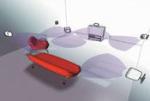
There are many different types of surround sound systems - 5.1, 6.1, & 7.1 configurations as well as other products that only use one or two speakers. So many configurations make it difficult to determine the right number of speakers a surround sound system should have to give you a rewarding surround experience.
The Facts about Surround Sound
There are many products that claim surround sound performance out of one or two speakers. Though some of these systems do a reasonable job of fooling listeners, do not consider any of them as surround sound systems.
In order to be a surround sound system, you need to have sound coming from behind or the side of the listener. Single or two speaker systems can use certain techniques to simulate the surround experience, but the results can vary widely based on certain factors, such as room shape and acoustics. For this reason, these systems are often referred to as simulated surround systems. It can be compared to simulated driving in an arcade machine versus hopping into a real car and driving on the expressway. The simulated experience just isn't the same as the real thing.
The remaining options are actual surround sound systems, consisting of anywhere from six to eight speakers. These are known as 5.1, 6.1, and 7.1 surround systems. The numeric designations indicate the number of speakers each surround sound system is comprised of.
The three common surround configurations
5.1
A 5.1 system is comprised of 5 full fidelity or satellite speakers and 1 low frequency effects speaker (known as a subwoofer). The low frequency effects channel is the .1, because it only produces low frequency sounds. This kind of configuration is arranged with three speakers in the front, two in the back or side, and one subwoofer. The 5.1 system is the industry standard for a surround system right now, and is the most commonly used arrangement. The majority of feature films are mixed for this kind of system.
On the positive side, a 5.1 system is the least expensive to put together and most pleasing to the eye, since it requires the least amount of speakers. The biggest disadvantage is that the surround sound field can often be lacking, leaving a large gap in the sound field directly behind listeners (like in the picture).
6.1
A 6.1 system differs from a 5.1 system by using more surround speakers. The 6.1 system adds a center rear speaker, designed to fill in the sound gap between the left and right surround speakers. When arranging a 6.1 system, the left and right surround speakers are usually moved to each side of the room, while the center back speaker is placed behind the listening area toward the middle. Many films are now available that are mixed to fully utilize the center rear speaker. However, even if the movie is only mixed in 5.1, the receiver can create sound for that speaker using advanced processing techniques. To take advantage of a 6.1 system, a compatible receiver with six amplifiers is required.
As just mentioned, the advantage of the 6.1 system is that removal of the sound gap in the back center allows for a more surrounded feel when listening movie soundtracks. On the other hand, if that speaker is too close to the listener, it may be easy to pinpoint the speaker's location when it plays a sound, which can be very distracting. Lastly, since many speakers are not sold individually, the 'extra' speaker may not mix quite as well with the rest of the speakers, since it might be a different brand or model than the other speakers in the system. When trying to keep the speakers the same, some are forced to buy two speakers, which means they end up with an extra speaker sitting on a shelf gathering dust.
7.1
A 7.1 system solves the two problems in a 6.1 system by dividing the sound for the center rear speaker into two separate speakers. This way if the speakers are closer to the listening space, or if there is a fairly large space behind the listening position, the two speakers will easily fill it in while make it hard to pinpoint the sound. In a 7.1 system, the two back speakers are referred to as the left and right back speakers, as opposed to the left and right surround speakers, which is very important to remember when wiring the speakers to the receiver.
The disadvantage is that a 7.1 system is the most expensive because the purchase involves buying more speakers, as well as a compatible receiver that has at least seven amplifiers built in. This system usually makes decor-crazed people unhappy because speakers seem to be sprouting off the walls everywhere in the room.
What's the right choice
So what system is the best? The best approach is usually to let the room decide. Many rooms cannot accommodate one or two center rear channels if the listening position is up against the back wall. Corner mounted home theaters can be a painful to work with, but 6.1 and 7.1 systems usually work out best in these applications because the back area is much larger and needs to be filled in. Small rooms with some, but little, space behind the listeners are usually best with 5.1 or 7.1 systems, as 6.1 puts a speaker right behind someone's head.
Remember, one configuration isn't better than another. Proper application will give the best performance in a surround sound system, not how many speakers are used.





Comments
I am working on configuring
I am working on configuring my Surround Sound to the best it can perform. I know I do not have top notch equipment. However, it is not the worst either. The system sounds good, but I do not think it has reached its potential.
Therefore, I was wondering were I could obtain a system configuration with the equipment I have? (wiring schematics and equipment lineup)
Could you help?